2014 FIAT 500L LIVING Battery
[x] Cancel search: BatteryPage 174 of 420
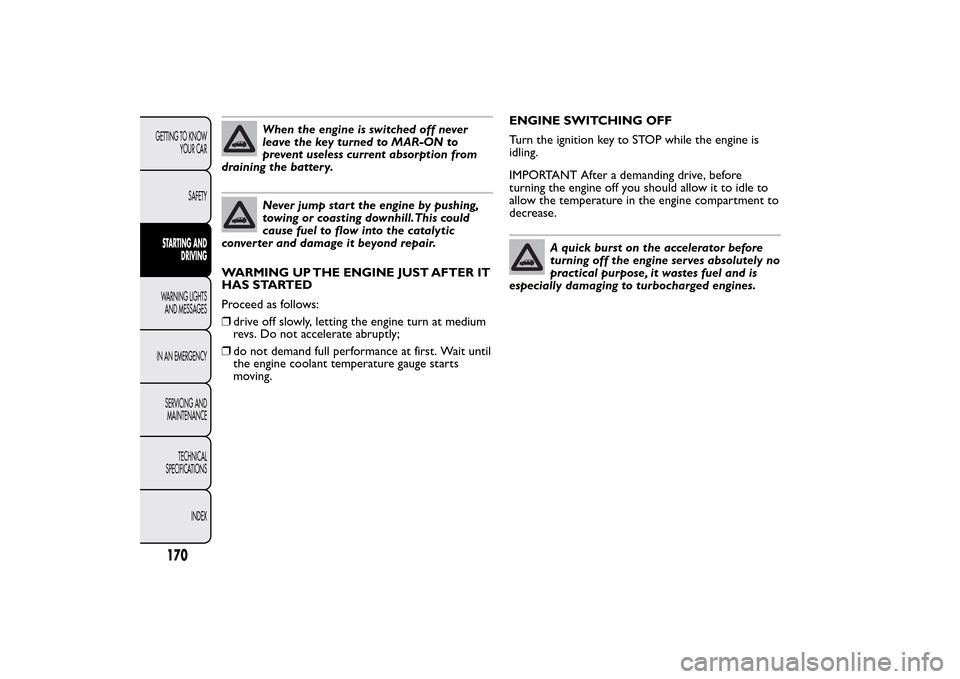
When the engine is switched off never
leave the key turned to MAR-ON to
prevent useless current absorption from
draining the battery.Never jump start the engine by pushing,
towing or coasting downhill.This could
cause fuel to flow into the catalytic
converter and damage it beyond repair.
WARMING UP THE ENGINE JUST AFTER IT
HAS STARTED
Proceed as follows:
❒drive off slowly, letting the engine turn at medium
revs. Do not accelerate abruptly;
❒do not demand full performance at first. Wait until
the engine coolant temperature gauge starts
moving.ENGINE SWITCHING OFF
Turn the ignition key to STOP while the engine is
idling.
IMPORTANT After a demanding drive, before
turning the engine off you should allow it to idle to
allow the temperature in the engine compartment to
decrease.
A quick burst on the accelerator before
turning off the engine serves absolutely no
practical purpose, it wastes fuel and is
especially damaging to turbocharged engines.
170GETTING TO KNOW
YOUR CAR
SAFETYSTARTING AND
DRIVINGWARNING LIGHTS
AND MESSAGES
IN AN EMERGENCY
SERVICING AND
MAINTENANCE
TECHNICAL
SPECIFICATIONS
INDEX
Page 175 of 420
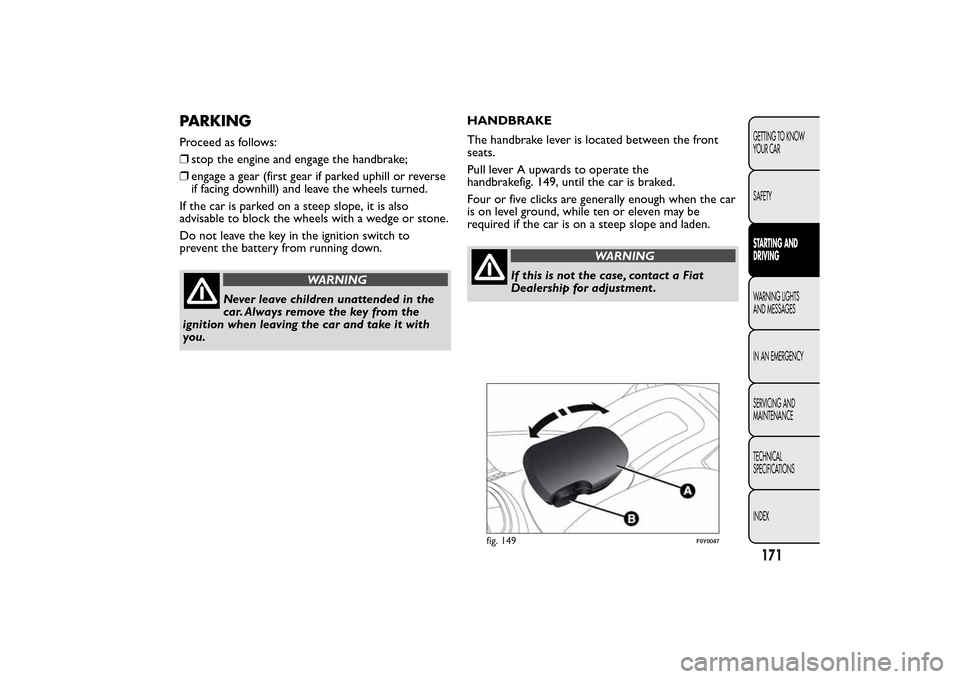
PARKINGProceed as follows:
❒stop the engine and engage the handbrake;
❒engage a gear (first gear if parked uphill or reverse
if facing downhill) and leave the wheels turned.
If the car is parked on a steep slope, it is also
advisable to block the wheels with a wedge or stone.
Do not leave the key in the ignition switch to
prevent the battery from running down.
WARNING
Never leave children unattended in the
car. Always remove the key from the
ignition when leaving the car and take it with
you.HANDBRAKE
The handbrake lever is located between the front
seats.
Pull lever A upwards to operate the
handbrakefig. 149, until the car is braked.
Four or five clicks are generally enough when the car
is on level ground, while ten or eleven may be
required if the car is on a steep slope and laden.
WARNING
If this is not the case, contact a Fiat
Dealership for adjustment .
fig. 149
F0Y0047
171GETTING TO KNOW
YOUR CAR
SAFETYSTARTING AND
DRIVINGWARNING LIGHTS
AND MESSAGES
IN AN EMERGENCY
SERVICING AND
MAINTENANCE
TECHNICAL
SPECIFICATIONS
INDEX
Page 180 of 420
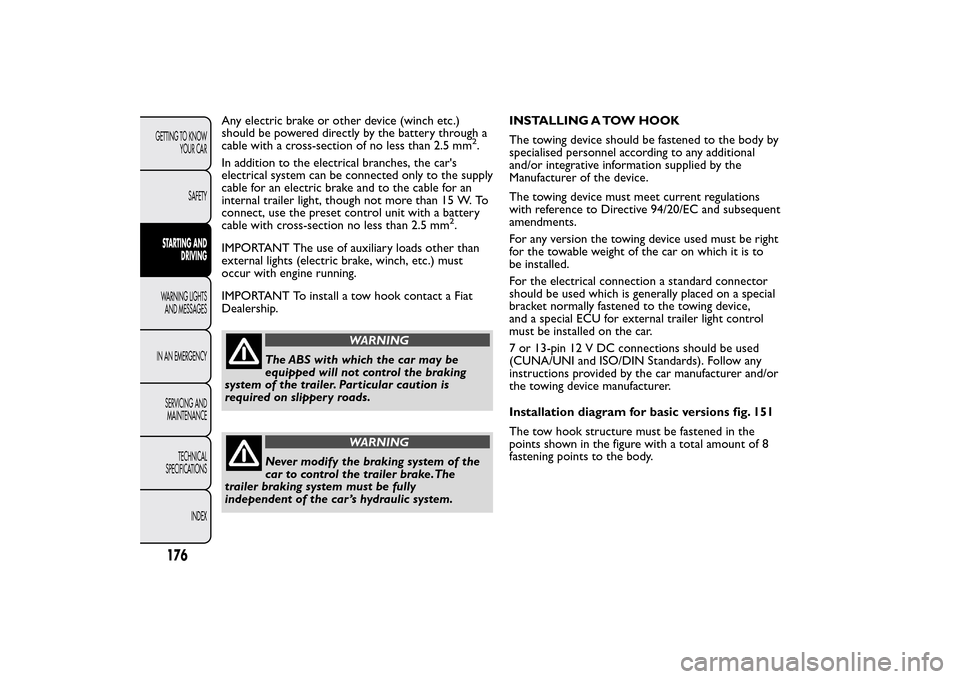
Any electric brake or other device (winch etc.)
should be powered directly by the battery through a
cable with a cross-section of no less than 2.5 mm
2.
In addition to the electrical branches, the car's
electrical system can be connected only to the supply
cable for an electric brake and to the cable for an
internal trailer light, though not more than 15 W. To
connect, use the preset control unit with a battery
cable with cross-section no less than 2.5 mm
2.
IMPORTANT The use of auxiliary loads other than
external lights (electric brake, winch, etc.) must
occur with engine running.
IMPORTANT To install a tow hook contact a Fiat
Dealership.
WARNING
The ABS with which the car may be
equipped will not control the braking
system of the trailer. Particular caution is
required on slippery roads.
WARNING
Never modify the braking system of the
car to control the trailer brake.The
trailer braking system must be fully
independent of the car ’s hydraulic system.INSTALLING A TOW HOOK
The towing device should be fastened to the body by
specialised personnel according to any additional
and/or integrative information supplied by the
Manufacturer of the device.
The towing device must meet current regulations
with reference to Directive 94/20/EC and subsequent
amendments.
For any version the towing device used must be right
for the towable weight of the car on which it is to
be installed.
For the electrical connection a standard connector
should be used which is generally placed on a special
bracket normally fastened to the towing device,
and a special ECU for external trailer light control
must be installed on the car.
7 or 13-pin 12 V DC connections should be used
(CUNA/UNI and ISO/DIN Standards). Follow any
instructions provided by the car manufacturer and/or
the towing device manufacturer.
Installation diagram for basic versions fig. 151
The tow hook structure must be fastened in the
points shown in the figure with a total amount of 8
fastening points to the body.
176GETTING TO KNOW
YOUR CAR
SAFETYSTARTING AND
DRIVINGWARNING LIGHTS
AND MESSAGES
IN AN EMERGENCY
SERVICING AND
MAINTENANCE
TECHNICAL
SPECIFICATIONS
INDEX
Page 185 of 420
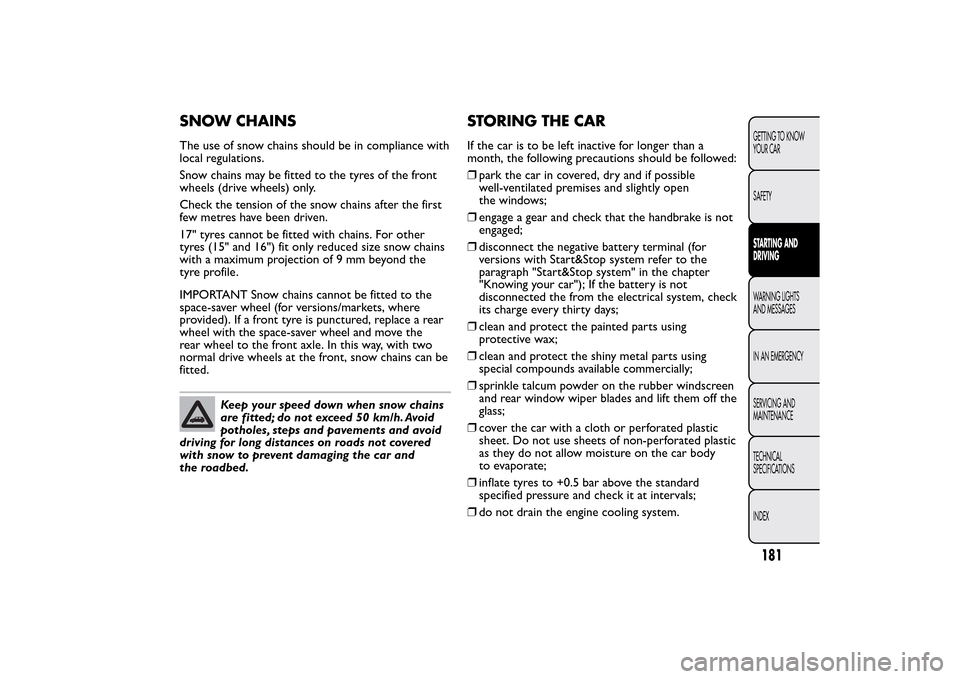
SNOW CHAINSThe use of snow chains should be in compliance with
local regulations.
Snow chains may be fitted to the tyres of the front
wheels (drive wheels) only.
Check the tension of the snow chains after the first
few metres have been driven.
17" tyres cannot be fitted with chains. For other
tyres (15" and 16") fit only reduced size snow chains
with a maximum projection of 9 mm beyond the
tyre profile.
IMPORTANT Snow chains cannot be fitted to the
space-saver wheel (for versions/markets, where
provided). If a front tyre is punctured, replace a rear
wheel with the space-saver wheel and move the
rear wheel to the front axle. In this way, with two
normal drive wheels at the front, snow chains can be
fitted.
Keep your speed down when snow chains
are fitted; do not exceed 50 km/h. Avoid
potholes, steps and pavements and avoid
driving for long distances on roads not covered
with snow to prevent damaging the car and
the roadbed.
STORING THE CARIf the car is to be left inactive for longer than a
month, the following precautions should be followed:
❒park the car in covered, dry and if possible
well-ventilated premises and slightly open
the windows;
❒engage a gear and check that the handbrake is not
engaged;
❒disconnect the negative battery terminal (for
versions with Start&Stop system refer to the
paragraph "Start&Stop system" in the chapter
"Knowing your car"); If the battery is not
disconnected the from the electrical system, check
its charge every thirty days;
❒clean and protect the painted parts using
protective wax;
❒clean and protect the shiny metal parts using
special compounds available commercially;
❒sprinkle talcum powder on the rubber windscreen
and rear window wiper blades and lift them off the
glass;
❒cover the car with a cloth or perforated plastic
sheet. Do not use sheets of non-perforated plastic
as they do not allow moisture on the car body
to evaporate;
❒inflate tyres to +0.5 bar above the standard
specified pressure and check it at intervals;
❒do not drain the engine cooling system.
181GETTING TO KNOW
YOUR CAR
SAFETYSTARTING AND
DRIVINGWARNING LIGHTS
AND MESSAGES
IN AN EMERGENCY
SERVICING AND
MAINTENANCE
TECHNICAL
SPECIFICATIONS
INDEX
Page 189 of 420
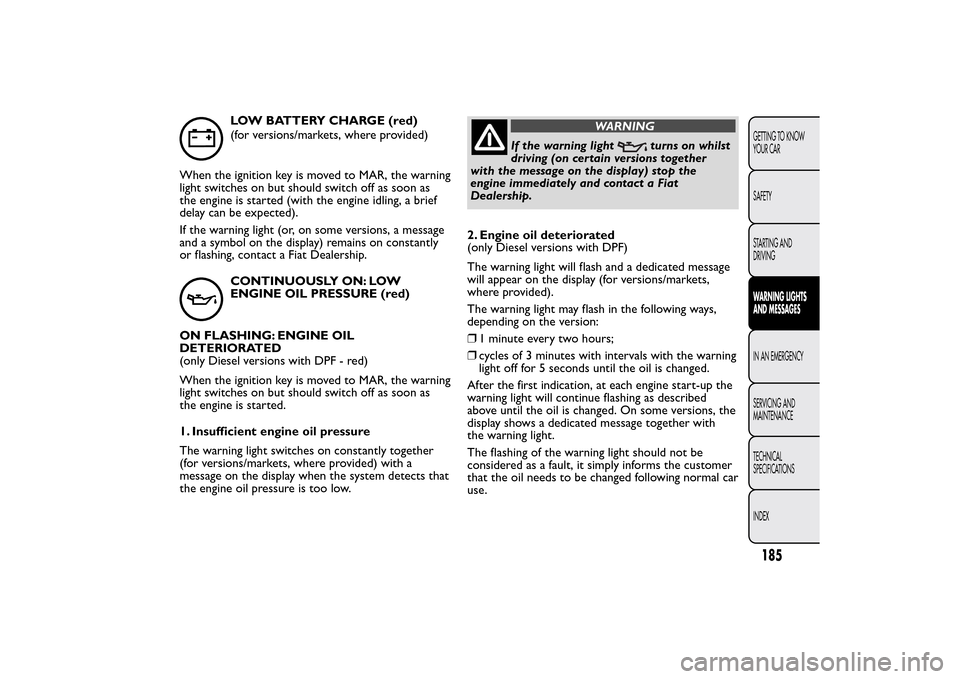
LOW BATTERY CHARGE (red)
(for versions/markets, where provided)
When the ignition key is moved to MAR, the warning
light switches on but should switch off as soon as
the engine is started (with the engine idling, a brief
delay can be expected).
If the warning light (or, on some versions, a message
and a symbol on the display) remains on constantly
or flashing, contact a Fiat Dealership.CONTINUOUSLY ON: LOW
ENGINE OIL PRESSURE (red)
ON FLASHING: ENGINE OIL
DETERIORATED
(only Diesel versions with DPF - red)
When the ignition key is moved to MAR, the warning
light switches on but should switch off as soon as
the engine is started.
1. Insufficient engine oil pressure
The warning light switches on constantly together
(for versions/markets, where provided) with a
message on the display when the system detects that
the engine oil pressure is too low.
WARNING
If the warning light
turns on whilst
driving (on cer tain versions together
with the message on the display) stop the
engine immediately and contact a Fiat
Dealership.
2. Engine oil deteriorated
(only Diesel versions with DPF)
The warning light will flash and a dedicated message
will appear on the display (for versions/markets,
where provided).
The warning light may flash in the following ways,
depending on the version:
❒1 minute every two hours;
❒cycles of 3 minutes with intervals with the warning
light off for 5 seconds until the oil is changed.
After the first indication, at each engine start-up the
warning light will continue flashing as described
above until the oil is changed. On some versions, the
display shows a dedicated message together with
the warning light.
The flashing of the warning light should not be
considered as a fault, it simply informs the customer
that the oil needs to be changed following normal car
use.
185GETTING TO KNOW
YOUR CAR
SAFETY
STARTING AND
DRIVINGWARNING LIGHTS
AND MESSAGESIN AN EMERGENCY
SERVICING AND
MAINTENANCE
TECHNICAL
SPECIFICATIONS
INDEX
Page 193 of 420
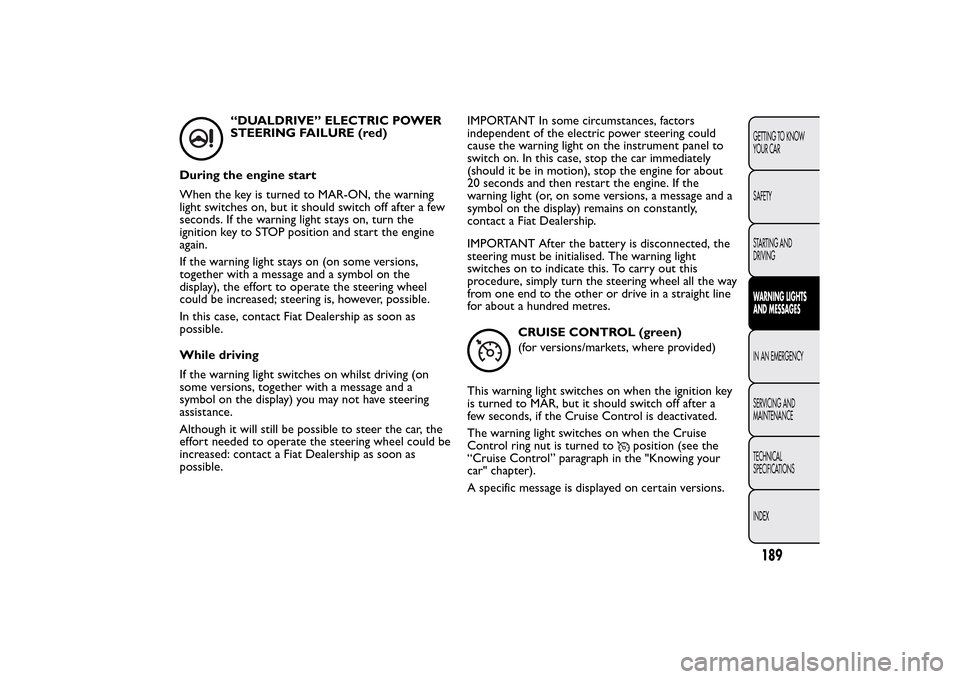
“DUALDRIVE” ELECTRIC POWER
STEERING FAILURE (red)
During the engine start
When the key is turned to MAR-ON, the warning
light switches on, but it should switch off after a few
seconds. If the warning light stays on, turn the
ignition key to STOP position and start the engine
again.
If the warning light stays on (on some versions,
together with a message and a symbol on the
display), the effort to operate the steering wheel
could be increased; steering is, however, possible.
In this case, contact Fiat Dealership as soon as
possible.
While driving
If the warning light switches on whilst driving (on
some versions, together with a message and a
symbol on the display) you may not have steering
assistance.
Although it will still be possible to steer the car, the
effort needed to operate the steering wheel could be
increased: contact a Fiat Dealership as soon as
possible.IMPORTANT In some circumstances, factors
independent of the electric power steering could
cause the warning light on the instrument panel to
switch on. In this case, stop the car immediately
(should it be in motion), stop the engine for about
20 seconds and then restart the engine. If the
warning light (or, on some versions, a message and a
symbol on the display) remains on constantly,
contact a Fiat Dealership.
IMPORTANT After the battery is disconnected, the
steering must be initialised. The warning light
switches on to indicate this. To carry out this
procedure, simply turn the steering wheel all the way
from one end to the other or drive in a straight line
for about a hundred metres.
CRUISE CONTROL (green)
(for versions/markets, where provided)
This warning light switches on when the ignition key
is turned to MAR, but it should switch off after a
few seconds, if the Cruise Control is deactivated.
The warning light switches on when the Cruise
Control ring nut is turned to
position (see the
“Cruise Control” paragraph in the "Knowing your
car" chapter).
A specific message is displayed on certain versions.
189GETTING TO KNOW
YOUR CAR
SAFETY
STARTING AND
DRIVINGWARNING LIGHTS
AND MESSAGESIN AN EMERGENCY
SERVICING AND
MAINTENANCE
TECHNICAL
SPECIFICATIONS
INDEX
Page 200 of 420
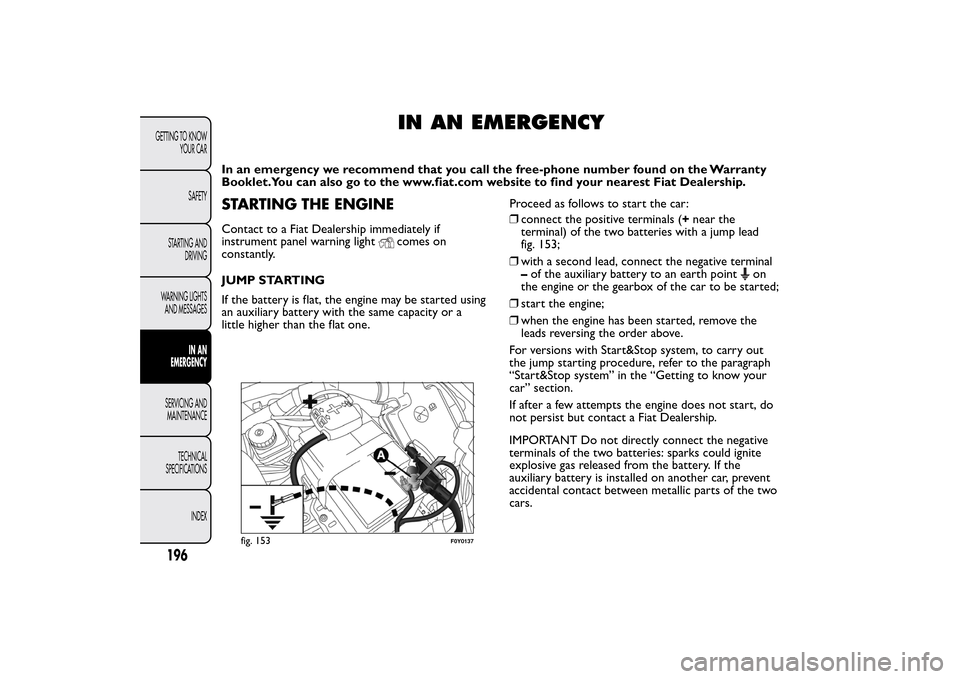
IN AN EMERGENCY
In an emergency we recommend that you call the free-phone number found on the Warranty
Booklet.You can also go to the www.fiat.com website to find your nearest Fiat Dealership.STARTING THE ENGINEContact to a Fiat Dealership immediately if
instrument panel warning light
comes on
constantly.
JUMP STARTING
If the battery is flat, the engine may be started using
an auxiliary battery with the same capacity or a
little higher than the flat one.Proceed as follows to start the car:
❒connect the positive terminals (+near the
terminal) of the two batteries with a jump lead
fig. 153;
❒with a second lead, connect the negative terminal
–of the auxiliary battery to an earth point
on
the engine or the gearbox of the car to be started;
❒start the engine;
❒when the engine has been started, remove the
leads reversing the order above.
For versions with Start&Stop system, to carry out
the jump starting procedure, refer to the paragraph
“Start&Stop system” in the “Getting to know your
car” section.
If after a few attempts the engine does not start, do
not persist but contact a Fiat Dealership.
IMPORTANT Do not directly connect the negative
terminals of the two batteries: sparks could ignite
explosive gas released from the battery. If the
auxiliary battery is installed on another car, prevent
accidental contact between metallic parts of the two
cars.
fig. 153
F0Y0137
196GETTING TO KNOW
YOUR CAR
SAFETY
STARTING AND
DRIVING
WARNING LIGHTS
AND MESSAGES
IN AN
EMERGENCY
SERVICING AND
MAINTENANCE
TECHNICAL
SPECIFICATIONS
INDEX
Page 201 of 420
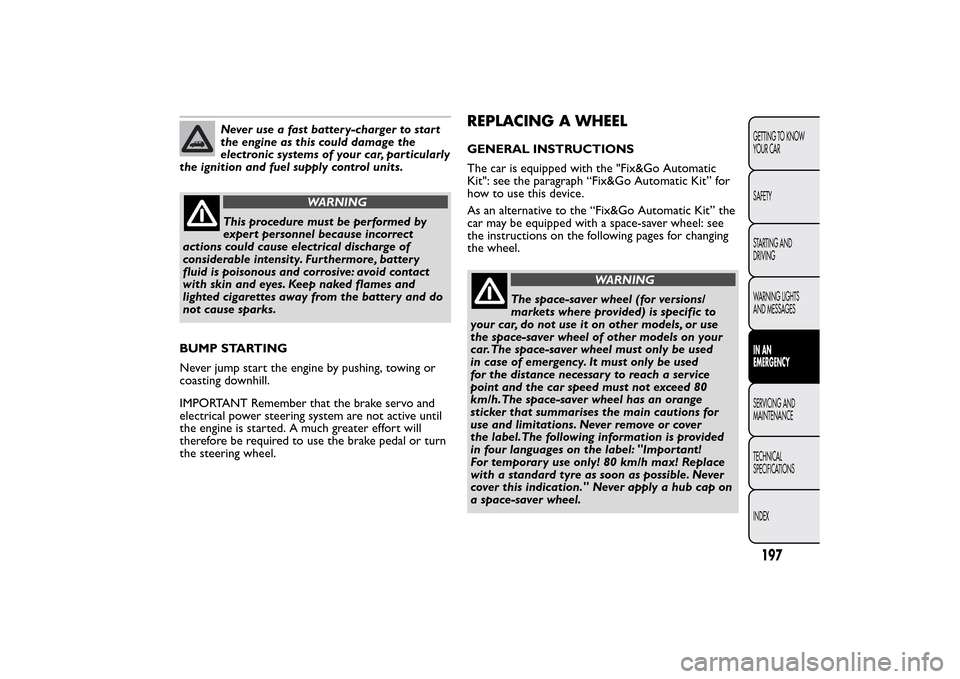
Never use a fast batter y-charger to star t
the engine as this could damage the
electronic systems of your car, particularly
the ignition and fuel supply control units.
WARNING
This procedure must be performed by
expert personnel because incorrect
actions could cause electrical discharge of
considerable intensity. Furthermore, battery
fluid is poisonous and corrosive: avoid contact
with skin and eyes. Keep naked flames and
lighted cigarettes away from the battery and do
not cause sparks.
BUMP STARTING
Never jump start the engine by pushing, towing or
coasting downhill.
IMPORTANT Remember that the brake servo and
electrical power steering system are not active until
the engine is started. A much greater effort will
therefore be required to use the brake pedal or turn
the steering wheel.
REPLACING A WHEELGENERAL INSTRUCTIONS
The car is equipped with the "Fix&Go Automatic
Kit": see the paragraph “Fix&Go Automatic Kit” for
how to use this device.
As an alternative to the “Fix&Go Automatic Kit” the
car may be equipped with a space-saver wheel: see
the instructions on the following pages for changing
the wheel.
WARNING
The space-saver wheel (for versions/
markets where provided) is specific to
your car, do not use it on other models, or use
the space-saver wheel of other models on your
car.The space-saver wheel must only be used
in case of emergency. It must only be used
for the distance necessary to reach a service
point and the car speed must not exceed 80
km/h.The space-saver wheel has an orange
sticker that summarises the main cautions for
use and limitations. Never remove or cover
the label.The following information is provided
in four languages on the label: "Important!
For temporary use only! 80 km/h max! Replace
with a standard tyre as soon as possible. Never
cover this indication." Never apply a hub cap on
a space-saver wheel.
197GETTING TO KNOW
YOUR CAR
SAFETY
STARTING AND
DRIVING
WARNING LIGHTS
AND MESSAGESIN AN
EMERGENCYSERVICING AND
MAINTENANCE
TECHNICAL
SPECIFICATIONS
INDEX